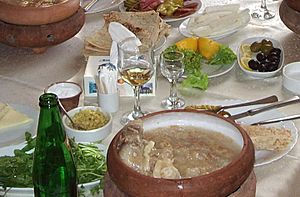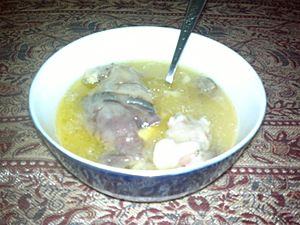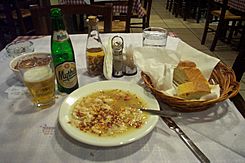Khash (dish) facts for kids

Khash (Armenian: խաշ) is a special meal made by boiling parts of a cow or sheep. This can include the head, feet, and stomach (which is called tripe).
It is also known by other names like pacha or serûpê.
Khash and similar dishes are traditional in many countries. These include Afghanistan, Albania, Armenia, Azerbaijan, Bosnia and Herzegovina, Bulgaria, Georgia, Greece, Iran, Iraq, Turkey, North Macedonia, Mongolia, and some Persian Gulf countries.
Contents
What's in a Name?
The name khash comes from the Armenian word (խաշել). This word means "to boil."
The dish was first called khashoy (Armenian: խաշոյ). Old Armenian writers, like Grigor Magistros (in the 11th century), mentioned it.
The Persian name pacha means "trotter" (an animal's foot). When you combine a sheep's head and trotters, it's called kalle-pāče. This means "head and trotter" in Persian.
Khash in the South Caucasus

Khash is a simple meal that uses only a few ingredients. The feet are cleaned of hair and soaked in cold water. This helps to remove any strong smell. Then, they are boiled slowly in water all night long. The water turns into a thick broth, and the meat falls off the bones.
No salt or spices are added while it boils. The dish is served hot. You can add salt, garlic, lemon juice, or vinegar to your taste. Sometimes, dried lavash (a type of flatbread) is crumbled into the broth. This makes the meal more filling.
Khash is often served with other foods. These can include hot green and yellow peppers, pickles, radishes, cheese, and fresh greens like cress.
In Georgia, Khashi is served with onions, milk, and salt. People usually eat this dish early in the morning.
Long ago, in a medieval Armenian medical book from 1184, khash was described as a healing food. It was thought to help with colds. Khash made from young lamb or kid legs was suggested for people who were sick.
Khash used to be a hearty winter food. Now, it is seen as a special treat. It is enjoyed as a festive winter meal. In Armenia, people traditionally eat it during months that have an "r" in their name. This means they usually avoid May, June, July, and August. Khash is also eaten in cold months in Azerbaijan and Georgia.
Eating khash often involves special traditions. Many people do not eat the evening before a khash party. They also insist on using only their hands to eat this meal. Because it is a very strong-smelling and filling dish, and eaten early, khash is usually served on weekends or holidays.
Khash in Iran
Kalle-pache (kalle-pāče) means "head and trotter." It is made from a sheep's head (including the brain) and trotters. It is often seasoned with lemon and cinnamon. This dish is usually eaten as a breakfast soup. It is traditional in Afghanistan and Iran.
In Iran, kalle-pache is often cooked in special shops. It is served in the morning, especially during cold seasons. To make kalle-pache, the sheep's head and trotters are gathered, cooked, and prepared following the recipe.
Khash in Israel
During winter, it is common to eat soup made from sheep or cow parts. This soup is served with onions, spices, and squeezed lemon. It can be prepared in many ways. Some types include:
- maraq regel (leg soup)
- maraq moh (brain soup)
- maraq me'ayim (intestine soup)
- maraq beten (tripe soup)
- maraq rosh (head soup)
It is usually eaten with flatbread, lemon for squeezing, and hot chili pepper.
Khash in Iraq
Pacha is a traditional Iraqi dish. It is made from sheep's head, trotters, and stomach. All parts are boiled slowly and served with bread soaked in the broth. The cheeks and tongue are thought to be the best parts. Many people choose not to eat the eyeballs, which can be removed before cooking. The stomach lining is sometimes filled with rice and lamb and sewn shut. Sheep brain is also included.
Khash in Arab Countries
This dish is known in Kuwait, Bahrain, and other Persian Gulf countries as Pacheh (پاچه). Because the Arabic alphabet does not have the sounds 'p' and 'ch', the dish is written as Bajeh (باجه).
A similar dish is found in other Arab countries like Egypt. It is called kawari' (كوارع). Egyptians eat cow brain and sheep brain.
Khash in Albania
Albania's popular paçe (paçe) is made from a sheep's or any cattle's head. The head is boiled until the meat easily comes off. Then, it is cooked with garlic, onion, black pepper, and vinegar. Sometimes, a little flour is added to make the stew thicker. It is also often cooked with cattle feet or tripe. It makes a hot and filling winter stew.
Khash in Turkey
In Turkish culinary culture, pacha (paça) is a general word for certain soup dishes. These often include offal (animal organs), but can also be made without it.
In most parts of Turkey, the term ayak paça ("feet pacha") is used for cow, sheep, or goat hooves. The term kelle paça is used for "head pacha" (a type of soup). Sometimes, dil paça is used for tongue soup. "Meat pacha" is made with gerdan (the neck part of a sheep).
In Turkey, the word kelle refers to a sheep's head roasted in the oven. This is served after grilling at special offal restaurants.
Khash in Greece
The Greek version is called patsás (πατσάς). It can be seasoned with red wine vinegar and garlic (skordostoubi). It can also be thickened with avgolémono (a sauce made with egg and lemon). The Greek version sometimes uses calf feet with the tripe.
Special restaurants called patsatzidika serve patsas. Patsas is known for helping with hangovers and digestion. Because of this, patsatzidika often stay open all night. They serve people coming home after dinner or clubbing.
Similar Dishes
- Paya, a similar dish from South Asia.
- Smalahove, boiled sheep's head, a traditional western Norwegian food.
- Soğuk paça, a Turkish cold dish. It is made from the jelly that comes from sheep or cow hooves.
- Svið, an Icelandic dish that includes a sheep's head cut in half.
See also
 In Spanish: Jash (comida) para niños
In Spanish: Jash (comida) para niños




